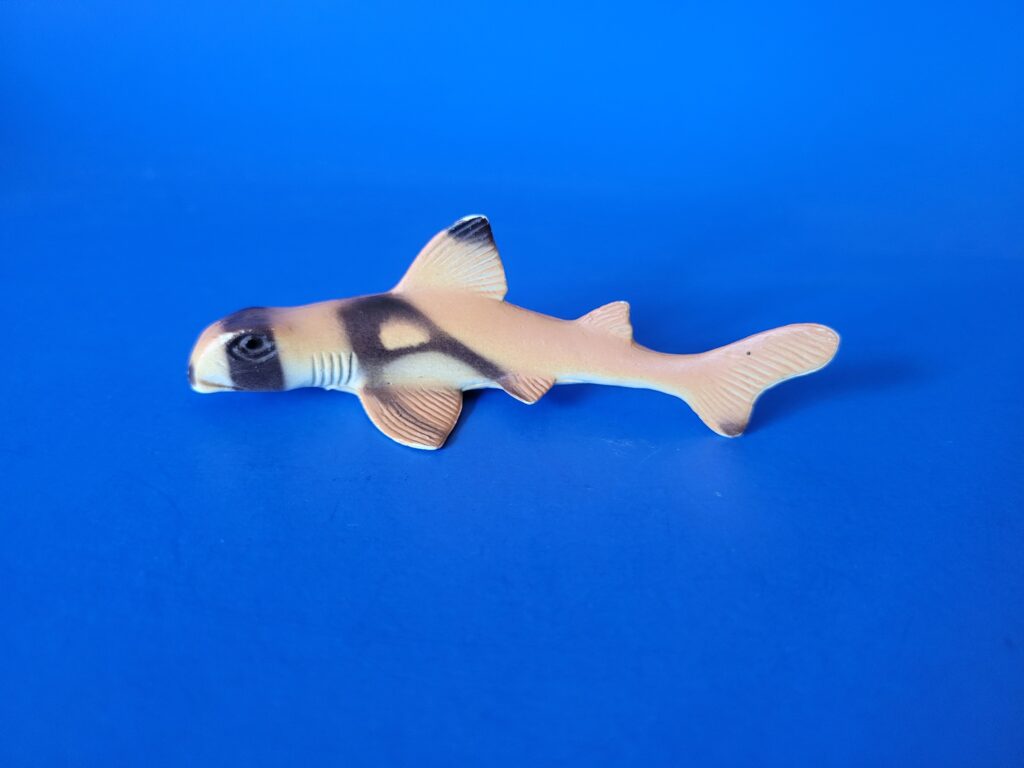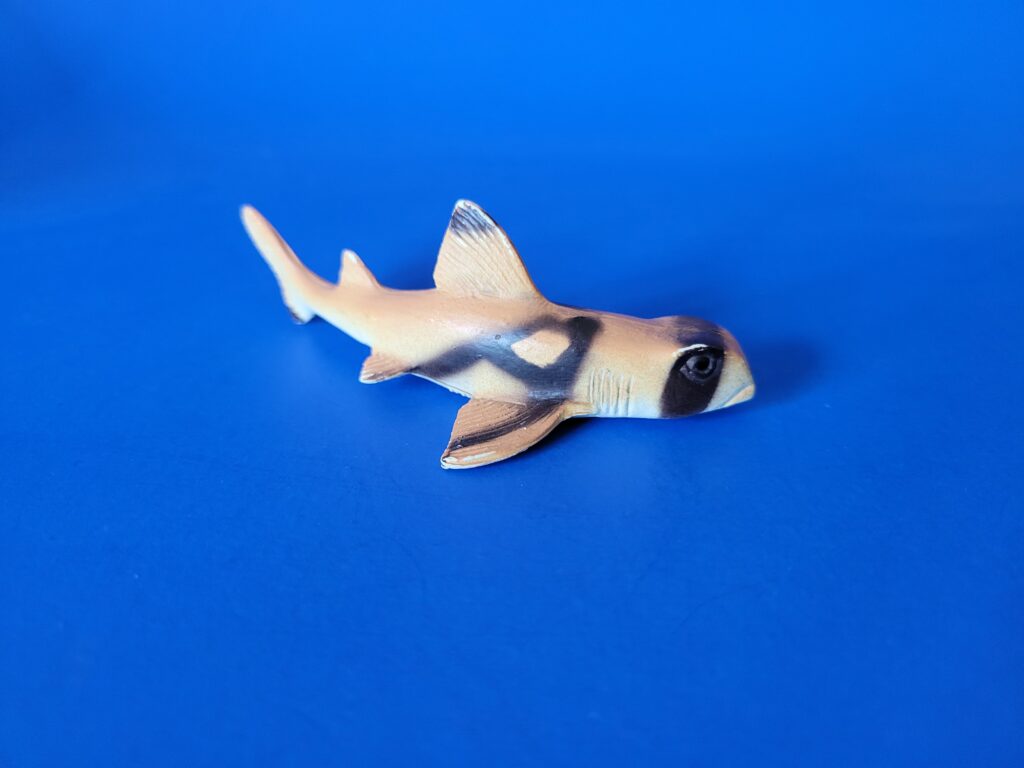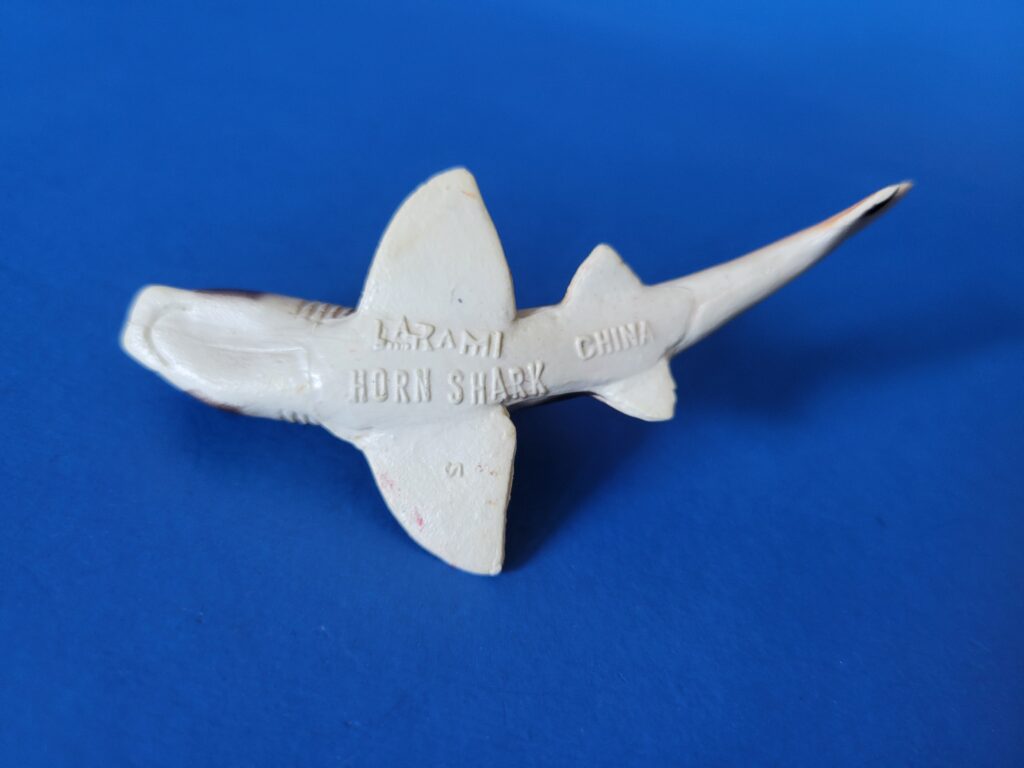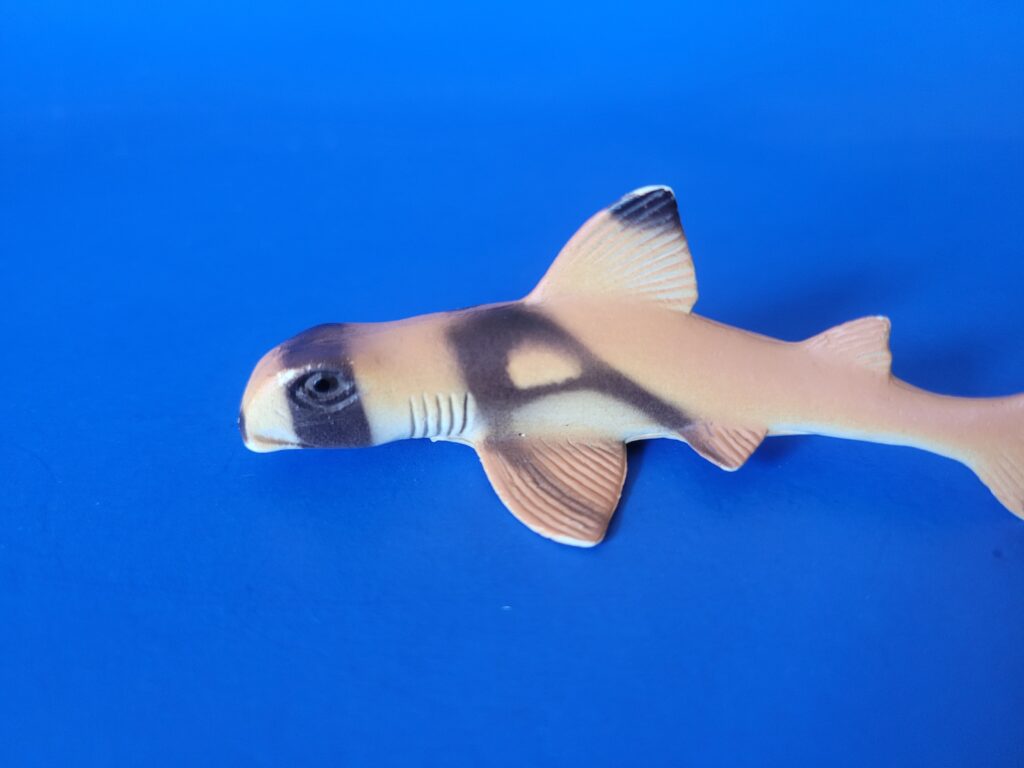
Welcome to Shark Week on the blog! This week we have themed posts for anyone who enjoys the finned world of the ocean- the finned world with teeth! To kick off the week I have the first submission: for the Port Jackson shark.
The Larami Port Jackson Shark was released in 1993 as part of a series of shark models that included common species like the bull, great white, and tiger sharks, but also includes several rare species in toy form such as the sand tiger shark, swellshark, greenland shark, and bonnethead shark. While many of the figures from the series are large, hollow, and have a poorer quality finish to them (including seams and lower quality paint application) the Port Jackson, at least to me, is one of the standout models from this series.

Getting into the real animals themselves, these guys are Australian and are named after Port Jackson Harbour in Sydney. Heterodontus portusjacksoni is the largest of the heterodontid sharks; they grow roughly 1.65 meters/5.41 feet long and are generally considered harmless to humans. They are one of three Australian species within its genus of ten: the crested bullhead and zebra bullhead sharks also reside in Australia, then we have the horn shark, Japanese bullhead, painted horn shark, Mexican horn shark, Oman bullhead, Galapagos bullhead, and the white-spotted bullhead shark. The PJS (the abbreviated term for the Port Jackson shark) has distinctive banding of pigment that creates a harness type of shape across the upper body and another around the head and eyes. They have unique “headstamps” on the dorsal portion of their head that researchers can use to help ID individuals. They are generally nocturnal, and will rest during the day in groups near reef caves to keep safe from larger animals on the prowl. This shark is unique from many others in that they can rest (unmoving) and pump water through their gills to breathe; and can also breathe while simultaneously eating. They feed on sea urchins, gastropods, echinoderms, crustaceans, and small fish in their reef habitat. They have unique teeth, amongst sharks, that are designed for more crushing and grinding rather than for slicing (the front teeth are pointed and sharp while the back are flat and blunt). But don’t be mistaken- if you are bitten by one of these animals it will be a nasty bite! They also have unique nostrils that are connected to their mouths. These guys have eye crests in addition to spines at the leading edge of both dorsal fins. They are somewhat migratory throughout the year; gathering in huge numbers around New South Wales to find mates between July and October. Their eggs come in a spiral shaped case which helps the eggs wedge into crevices in their reef side home. These structures will be the safe haven for the young sharks while they dodge predators including their close cousins the crested bullhead and even adults of their own species.

This particular figure is posed in a rather neutral posture, with only a slight curve to the lower half of it’s body, the tail gently curving to the left. And the simplicity of this model doesn’t stop there; the paint work is a two-tone application with a tan base and dark brown striping across its nose, eyes, pectoral fins, pelvic fins, and tip of the dorsal fin and bottom tip of the main tail fin. The actual paint work itself is also simplistically done and the banding of the brown blends itself rather well in the transition to the lighter body color. You can see some detail on the figure also, including around its eye orbits, mouth, gills, and across the main fin arrangements; however, beyond this the figure is smooth and untextured. Even though the model itself is rather simple and straightforward, I do think it is the best model for this species out there to date as of this writing. It has the most realistic look to it and doesn’t try to imitate anything more dramatic that is sometimes present in other shark figures. The model itself was stamped as a horn shark, but given the distinct pattern this could not be mistaken for anything other than a Port Jackson.
In either case, this is a rather special little shark species and an even more special figure of one as there are so few. Perhaps it can swim into your collection?

Disclaimer: links to Ebay and Amazon on the AnimalToyBlog are affiliate links, so we make a small commission if you use them. Thanks for supporting us!




After I saw this in draft, I went on eBay and found a lot of eight Larami sharks for only $6 (before shipping) that included this species, so I bought it!
The set also had their sandbar shark, which I think is a unique figure, but not sue I’ll keep that one as it’s not as good.
Yes, the sandbar shark and the blacktip shark are the two species from the Larami sharks that have never been made by any other company. The blacktip is intended to be Carcharhinus limbatus and not the commonly produced blacktip reef shark, C. melanopterus; it is labeled as C. limbatus in the boxset leaflet and the facts provided correspond to C. limbatus and not C. melanopterus. And, unlike the PJS/horn shark issue, the generic blue painting on the model itself makes more sense for C. limbatus that C. melanopterus.
It is unfortunate that both those two unique species have the same mold, and the mold itself is not exactly an amazing depiction of either shark. Check if your lot came with the blacktip as well if you are looking to expand your shark species lineup, although those models have definitely aged far worse than Larami’s PJS
unfortunately no; it comes with the bull shark and three Larami whales.
…but I just found another very cheap small lot with the blacktip! Thanks for the tip. TAI currently has it misidentified.
Happy to help! I got mine in a lot I purchased for the greenland shark and PJS, and initially didn’t think much of it, figuring Larami probably meant the far more popular C. melanopterus… but when I came across an image of the leaflet, I was pleasantly surprised to have been wrong!
Great start to Shark Week! This is the Port Jackson Shark model I chose for my collection too. It’s an odd situation, because as you said the paintwork is clearly of a PJS, but it’s labeled “Horn Shark”. The informational leaflet that came with the Larami boxsets doubles down on this; there, it lists the horn shark as coming in the set, provides the latin name of the horn shark, Heterodontus francisci, depicts an illustration of a horn shark (with a spotty pattern instead of the PJS’s distinctive “A”), and provides facts about H. francisci (like it living off Southern California). So it was meant to be a horn shark, but I guess whoever in charge of the paint design work was erroneously looking at a PJS for reference. Funnily enough, the Wild Republic tube figure is also labeled a horn shark, but painted like a PJS. This gives the horn shark the odd distinction of having both two figures in its name, yet no figures depicting it at all! Hope the horn shark gets a figure that actually resembles it one day
Cadbury produced a PJS for the original Australian Yowies line (and named it and painted it properly LOL)
https://www.asahi-net.or.jp/~CH2M-NITU/eggay4e.htm
I would love to have a PJS in my collection, or any horn shark, but I just cannot be bothered with these crude vintage figures. Even if it’s the only option. Hopefully CollectA or Safari will produce one. CollectA did an angel shark so I’m feeling optimistic.
Even though I don’t like the figure I’m happy to see it here and it’s great for kicking off Shark Week. Wonderful review!
I had the entire Larami set of sharks at one time, but I sold it decades ago. Same reason — the style was just too rough (I was used to Kaiyodo and Colorata by then)